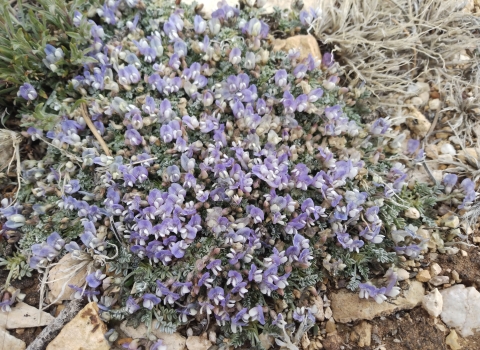ALBUQUERQUE—The U.S. Fish and Wildlife Service has finalized regulations under the Endangered Species Act (ESA) to protect the Wright’s marsh thistle, a plant from the sunflower family that is endemic to New Mexico. The Wright’s marsh thistle will be protected as a threatened species with an ESA Section 4(d) rule, and 156.8 acres will be designated as its critical habitat.
This striking thistle was historically known to occur in wetland habitats with alkaline soils across Arizona and New Mexico in the United States and Chihuahua and Sonora in Mexico. As its name implies, it is a rare wetland species that needs marshy habitats with year-round water-saturated soils to thrive. This plant can grow up to eight feet tall, displays white or bright pink flowered depending on locality, and is found in eight localities in New Mexico.
After a review of the best available scientific and commercial information, the Service determined the Wright’s marsh thistle is at risk of extinction in the foreseeable future due to the scarcity, small size and isolation of its remaining populations. Additional threats to the species include decreased water availability, competition with native and non-native plants, ungulate grazing and effects from oil, gas, and mining development.
The ESA listing of the Wright’s marsh thistle as threatened will support both new and current conservation efforts for the species. The special 4(d) rule tailor protections to those needed to recover the thistle, such as prohibiting the damage, destruction or removal of the plant on federal lands, while streamlining regulatory processes for minor impacts.
The Service is finalizing eight units of critical habitat totaling 156.8 acres in Chaves, Eddy, Guadalupe, Otero and Socorro counties in New Mexico. The majority of the proposed units overlap with existing critical habitat for 10 other listed species. Designation of critical habitat does not affect land ownership, establish a refuge or preserve, and has no impact on private landowners taking actions on their land that do not require federal funding or permits.
Native plants are important for their ecological, economic and aesthetic values. Plants play an important role in the development of crops that resist disease, insects and drought. At least 25 percent of prescription drugs contain ingredients derived from plant compounds, including medicine to treat cancer, heart disease, juvenile leukemia and malaria and to assist in organ transplants. Plants are also used to develop natural pesticides.
The final listing determination, 4(d) rule and critical habitat designation will publish in the Federal Register on April 25, 2023, and will be effective 30 days after publication. For more information, visit on the Wright’s marsh thistle species profile page: https://ecos.fws.gov/ecp/species/8963.
America’s fish, wildlife and plant resources belong to all of us, and ensuring the health of imperiled species is a shared responsibility. The Service is actively engaged with conservation partners and the public in the search for improved and innovative ways to conserve and recover imperiled species. To learn more about the Endangered Species program, go to http://www.fws.gov/endangered/.


